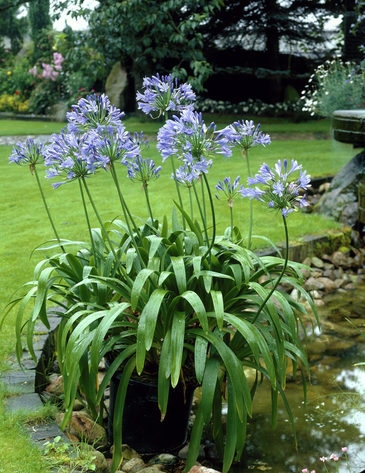Mastering the Art of Agapanthus Treatment: Vital Steps for Healthy Development and Vibrant Flowers
In the realm of gardening, the cultivation of agapanthus stands as a gratifying undertaking for those that seek to support these stylish blooming plants. With their striking blooms and elegant foliage, agapanthus has captured the attention of gardeners worldwide. However, attaining optimum development and vibrant blossoms requires a nuanced approach that encompasses numerous vital steps. From choosing the best range to grasping pruning methods, the journey towards cultivating thriving agapanthus plants is diverse and holds the vital to opening the full possibility of these botanical treasures.

Choosing the Right Agapanthus Range

When choosing the ideal Agapanthus variety for your garden, consider variables such as environment suitability, blossom color, and growth habit. Agapanthus, generally called Lily of the Nile or African lily, comes in a variety of shades varying from shades of blue and purple to white. Choose a bloom shade that matches your existing garden combination to produce an unified landscape. In addition, think about the environment in your region to make sure the Agapanthus variety you choose can grow in your particular problems. Some ranges are a lot more tolerant of cool temperatures, while others prefer warmer environments. Comprehending the growth behavior of different Agapanthus selections is important for appropriate placement within your garden. Some varieties have a clumping development routine, perfect for containers or borders, while others have an even more spreading nature, ideal for ground cover or mass growings. By thoroughly reviewing these factors, you can choose the excellent Agapanthus variety to improve the elegance of your yard.
Suitable Planting Problems
Taking into consideration the ideal environmental requirements is important for effective Agapanthus farming. Agapanthus plants are delicate to chilly temperatures and ought to be secured from frost during winter season months.
To ensure healthy and balanced growth and dynamic blossoms, plant Agapanthus light bulbs at a deepness of regarding 2-4 inches and room them 8-12 inches apart. Mulching around the base of the plants aids maintain wetness and suppresses weed growth.
Watering and Fertilizing Tips
Maintaining proper moisture degrees and offering important nutrients are crucial elements in the treatment program for Agapanthus plants. When it comes to sprinkling Agapanthus, it is critical to strike a balance. These plants like continually moist soil yet are susceptible to root rot if overwatered.
Fertilizing Agapanthus is essential for advertising healthy growth and respected blooms. Use a balanced plant food, such as a 10-10-10 formula, in the very early spring as brand-new growth arises. By adhering to these watering and fertilizing tips, you can ensure your Agapanthus plants thrive and generate vibrant, resilient flowers.
Trimming Methods for Agapanthus
Trimming Agapanthus plants at the suitable times and with appropriate methods is essential for maintaining their health and wellness and advertising optimal growth and flowering. The optimal time to prune Agapanthus is in late wintertime or very early springtime prior to new growth arises.
For flowered stems, wait until the blossoms have actually perished and afterwards trim them back to the base. This not just cleans the plant's look but also urges the growth of new flower buds. Deadheading invested blossoms can likewise reroute the plant's look at this web-site power into generating even more blooms as opposed to setting seeds. Nonetheless, if you wish to gather seeds for propagation, leave some blossoms to mature and completely dry on the plant.
Bear in mind to make use of tidy, sharp devices to make exact cuts and lower the risk of presenting illness. Agapanthus. Routine trimming will aid maintain your Agapanthus looking neat and healthy and balanced while guaranteeing an abundant screen of gorgeous flowers
Taking Care Of Typical Parasites and Diseases
After ensuring correct trimming techniques for Agapanthus, it is vital to address typical insects and diseases that can affect the health and wellness and vitality of these plants. Agapanthus navigate to this website plants are usually hardy however can still come down with specific problems. One typical pest that influences Agapanthus is the Agapanthus gall midge. This little, orange fly lays its eggs in the foliage, leading to altered growth and flower buds that fail to open. To fight this bug, trim and destroy any damaged plant parts and think about using insecticidal soap.
One more common issue is fungal leaf place, which presents as dark sores on the fallen leaves. To avoid fungal diseases, guarantee excellent air circulation around the plants, stay clear of overhead watering, and remove any type of infected fallen leaves promptly. Additionally, Agapanthus plants can struggle with root rot if they are planted in inadequately draining dirt. To avoid this, plant Agapanthus in well-draining dirt and prevent overwatering. By being cautious and taking prompt activity against illness and bugs, you can help your Agapanthus plants flourish and create lively flowers.

Conclusion
To conclude, grasping the art of agapanthus treatment involves choosing the best range, giving ideal growing problems, their website appropriate watering and fertilizing, ideal trimming strategies, and dealing with usual bugs and illness. By complying with these essential steps, you can ensure healthy growth and vibrant blooms for your agapanthus plants. Bear in mind to regularly monitor and preserve your plants to advertise their overall well-being and long life.
To ensure healthy growth and dynamic flowers, plant Agapanthus bulbs at a deepness of concerning 2-4 inches and room them 8-12 inches apart. By following these watering and feeding tips, you can ensure your Agapanthus plants flourish and generate lively, long-lasting blooms.
One usual pest that influences Agapanthus is the Agapanthus gall midge. In addition, Agapanthus plants can endure from root rot if they are grown in badly draining dirt. By complying with these necessary actions, you can ensure healthy and balanced development and vivid blossoms for your agapanthus plants.